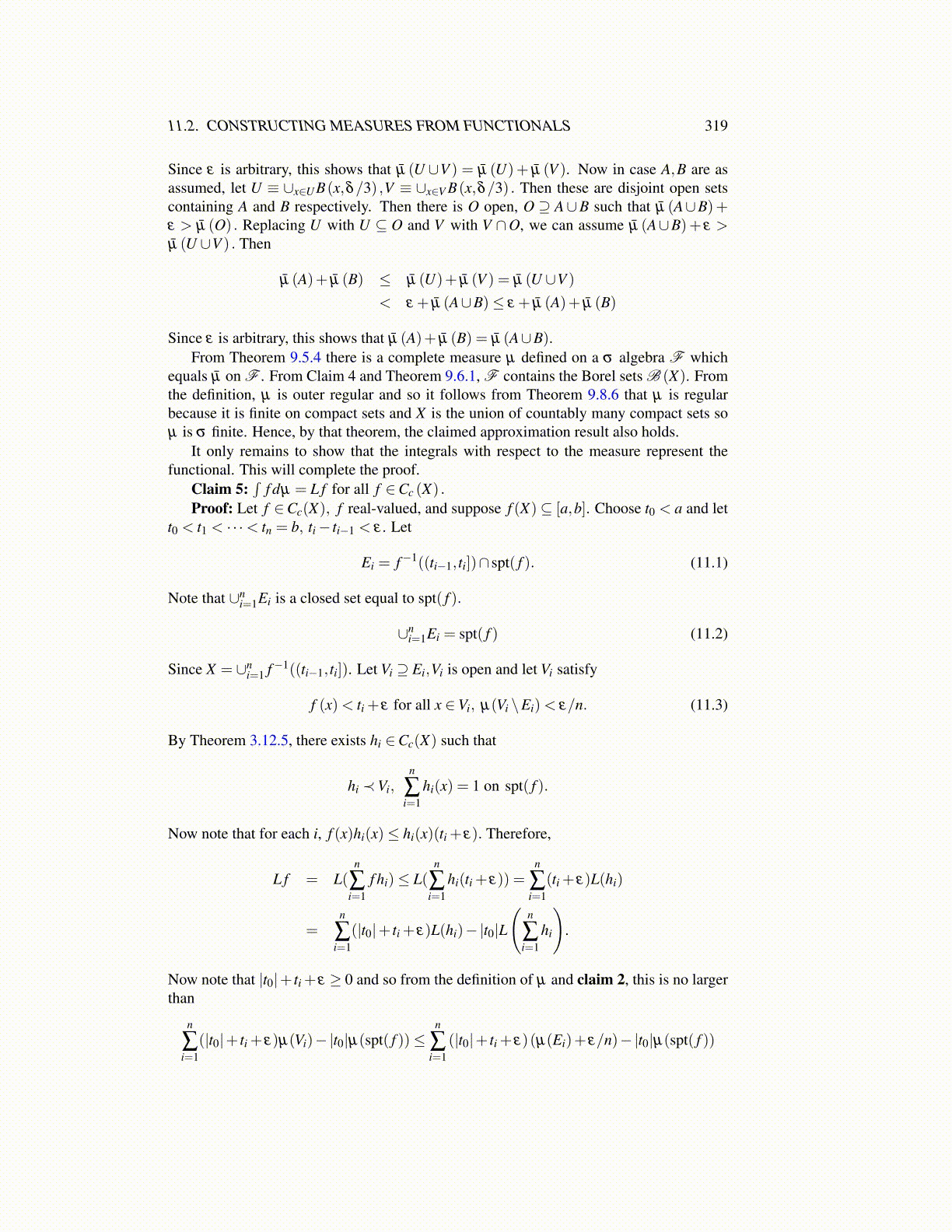
11.2. CONSTRUCTING MEASURES FROM FUNCTIONALS 319
Since ε is arbitrary, this shows that µ̄ (U ∪V ) = µ̄ (U)+ µ̄ (V ). Now in case A,B are asassumed, let U ≡ ∪x∈U B(x,δ/3) ,V ≡ ∪x∈V B(x,δ/3) . Then these are disjoint open setscontaining A and B respectively. Then there is O open, O ⊇ A∪B such that µ̄ (A∪B)+ε > µ̄ (O) . Replacing U with U ⊆ O and V with V ∩O, we can assume µ̄ (A∪B)+ ε >µ̄ (U ∪V ) . Then
µ̄ (A)+ µ̄ (B) ≤ µ̄ (U)+ µ̄ (V ) = µ̄ (U ∪V )
< ε + µ̄ (A∪B)≤ ε + µ̄ (A)+ µ̄ (B)
Since ε is arbitrary, this shows that µ̄ (A)+ µ̄ (B) = µ̄ (A∪B).From Theorem 9.5.4 there is a complete measure µ defined on a σ algebra F which
equals µ̄ on F . From Claim 4 and Theorem 9.6.1, F contains the Borel sets B (X). Fromthe definition, µ is outer regular and so it follows from Theorem 9.8.6 that µ is regularbecause it is finite on compact sets and X is the union of countably many compact sets soµ is σ finite. Hence, by that theorem, the claimed approximation result also holds.
It only remains to show that the integrals with respect to the measure represent thefunctional. This will complete the proof.
Claim 5:∫
f dµ = L f for all f ∈Cc (X) .Proof: Let f ∈Cc(X), f real-valued, and suppose f (X)⊆ [a,b]. Choose t0 < a and let
t0 < t1 < · · ·< tn = b, ti− ti−1 < ε . Let
Ei = f−1((ti−1, ti])∩ spt( f ). (11.1)
Note that ∪ni=1Ei is a closed set equal to spt( f ).
∪ni=1Ei = spt( f ) (11.2)
Since X = ∪ni=1 f−1((ti−1, ti]). Let Vi ⊇ Ei,Vi is open and let Vi satisfy
f (x)< ti + ε for all x ∈Vi, µ(Vi \Ei)< ε/n. (11.3)
By Theorem 3.12.5, there exists hi ∈Cc(X) such that
hi ≺Vi,n
∑i=1
hi(x) = 1 on spt( f ).
Now note that for each i, f (x)hi(x)≤ hi(x)(ti + ε). Therefore,
L f = L(n
∑i=1
f hi)≤ L(n
∑i=1
hi(ti + ε)) =n
∑i=1
(ti + ε)L(hi)
=n
∑i=1
(|t0|+ ti + ε)L(hi)−|t0|L
(n
∑i=1
hi
).
Now note that |t0|+ ti + ε ≥ 0 and so from the definition of µ and claim 2, this is no largerthan
n
∑i=1
(|t0|+ ti + ε)µ(Vi)−|t0|µ(spt( f ))≤n
∑i=1
(|t0|+ ti + ε)(µ(Ei)+ ε/n)−|t0|µ(spt( f ))